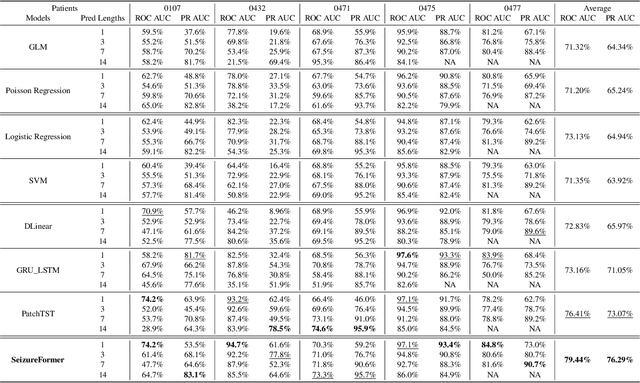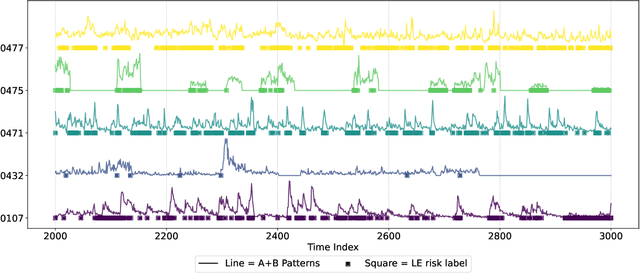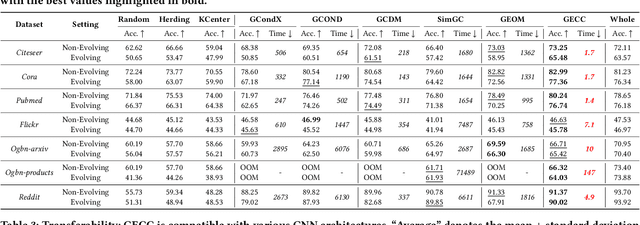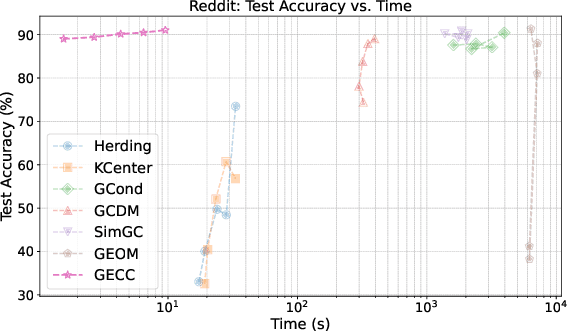Wei Jin
Department of Computer Science, Emory University, Atlanta, GA, USA
Generalist vs Specialist Time Series Foundation Models: Investigating Potential Emergent Behaviors in Assessing Human Health Using PPG Signals
Oct 16, 2025Abstract:Foundation models are large-scale machine learning models that are pre-trained on massive amounts of data and can be adapted for various downstream tasks. They have been extensively applied to tasks in Natural Language Processing and Computer Vision with models such as GPT, BERT, and CLIP. They are now also increasingly gaining attention in time-series analysis, particularly for physiological sensing. However, most time series foundation models are specialist models - with data in pre-training and testing of the same type, such as Electrocardiogram, Electroencephalogram, and Photoplethysmogram (PPG). Recent works, such as MOMENT, train a generalist time series foundation model with data from multiple domains, such as weather, traffic, and electricity. This paper aims to conduct a comprehensive benchmarking study to compare the performance of generalist and specialist models, with a focus on PPG signals. Through an extensive suite of total 51 tasks covering cardiac state assessment, laboratory value estimation, and cross-modal inference, we comprehensively evaluate both models across seven dimensions, including win score, average performance, feature quality, tuning gain, performance variance, transferability, and scalability. These metrics jointly capture not only the models' capability but also their adaptability, robustness, and efficiency under different fine-tuning strategies, providing a holistic understanding of their strengths and limitations for diverse downstream scenarios. In a full-tuning scenario, we demonstrate that the specialist model achieves a 27% higher win score. Finally, we provide further analysis on generalization, fairness, attention visualizations, and the importance of training data choice.
Can Large Language Models Adequately Perform Symbolic Reasoning Over Time Series?
Aug 05, 2025Abstract:Uncovering hidden symbolic laws from time series data, as an aspiration dating back to Kepler's discovery of planetary motion, remains a core challenge in scientific discovery and artificial intelligence. While Large Language Models show promise in structured reasoning tasks, their ability to infer interpretable, context-aligned symbolic structures from time series data is still underexplored. To systematically evaluate this capability, we introduce SymbolBench, a comprehensive benchmark designed to assess symbolic reasoning over real-world time series across three tasks: multivariate symbolic regression, Boolean network inference, and causal discovery. Unlike prior efforts limited to simple algebraic equations, SymbolBench spans a diverse set of symbolic forms with varying complexity. We further propose a unified framework that integrates LLMs with genetic programming to form a closed-loop symbolic reasoning system, where LLMs act both as predictors and evaluators. Our empirical results reveal key strengths and limitations of current models, highlighting the importance of combining domain knowledge, context alignment, and reasoning structure to improve LLMs in automated scientific discovery.
TimeRecipe: A Time-Series Forecasting Recipe via Benchmarking Module Level Effectiveness
Jun 06, 2025Abstract:Time-series forecasting is an essential task with wide real-world applications across domains. While recent advances in deep learning have enabled time-series forecasting models with accurate predictions, there remains considerable debate over which architectures and design components, such as series decomposition or normalization, are most effective under varying conditions. Existing benchmarks primarily evaluate models at a high level, offering limited insight into why certain designs work better. To mitigate this gap, we propose TimeRecipe, a unified benchmarking framework that systematically evaluates time-series forecasting methods at the module level. TimeRecipe conducts over 10,000 experiments to assess the effectiveness of individual components across a diverse range of datasets, forecasting horizons, and task settings. Our results reveal that exhaustive exploration of the design space can yield models that outperform existing state-of-the-art methods and uncover meaningful intuitions linking specific design choices to forecasting scenarios. Furthermore, we release a practical toolkit within TimeRecipe that recommends suitable model architectures based on these empirical insights. The benchmark is available at: https://github.com/AdityaLab/TimeRecipe.
SeizureFormer: A Transformer Model for IEA-Based Seizure Risk Forecasting
Apr 24, 2025



Abstract:We present SeizureFormer, a Transformer-based model for long-term seizure risk forecasting using interictal epileptiform activity (IEA) surrogate biomarkers and long episode (LE) biomarkers from responsive neurostimulation (RNS) systems. Unlike raw scalp EEG-based models, SeizureFormer leverages structured, clinically relevant features and integrates CNN-based patch embedding, multi-head self-attention, and squeeze-and-excitation blocks to model both short-term dynamics and long-term seizure cycles. Tested across five patients and multiple prediction windows (1 to 14 days), SeizureFormer achieved state-of-the-art performance with mean ROC AUC of 79.44 percent and mean PR AUC of 76.29 percent. Compared to statistical, machine learning, and deep learning baselines, it demonstrates enhanced generalizability and seizure risk forecasting performance under class imbalance. This work supports future clinical integration of interpretable and robust seizure forecasting tools for personalized epilepsy management.
Graph ODEs and Beyond: A Comprehensive Survey on Integrating Differential Equations with Graph Neural Networks
Mar 29, 2025Abstract:Graph Neural Networks (GNNs) and differential equations (DEs) are two rapidly advancing areas of research that have shown remarkable synergy in recent years. GNNs have emerged as powerful tools for learning on graph-structured data, while differential equations provide a principled framework for modeling continuous dynamics across time and space. The intersection of these fields has led to innovative approaches that leverage the strengths of both, enabling applications in physics-informed learning, spatiotemporal modeling, and scientific computing. This survey aims to provide a comprehensive overview of the burgeoning research at the intersection of GNNs and DEs. We will categorize existing methods, discuss their underlying principles, and highlight their applications across domains such as molecular modeling, traffic prediction, and epidemic spreading. Furthermore, we identify open challenges and outline future research directions to advance this interdisciplinary field. A comprehensive paper list is provided at https://github.com/Emory-Melody/Awesome-Graph-NDEs. This survey serves as a resource for researchers and practitioners seeking to understand and contribute to the fusion of GNNs and DEs
Scalable Graph Condensation with Evolving Capabilities
Feb 24, 2025



Abstract:Graph data has become a pivotal modality due to its unique ability to model relational datasets. However, real-world graph data continues to grow exponentially, resulting in a quadratic increase in the complexity of most graph algorithms as graph sizes expand. Although graph condensation (GC) methods have been proposed to address these scalability issues, existing approaches often treat the training set as static, overlooking the evolving nature of real-world graph data. This limitation leads to inefficiencies when condensing growing training sets. In this paper, we introduce GECC (Graph Evolving Clustering Condensation), a scalable graph condensation method designed to handle large-scale and evolving graph data. GECC employs a traceable and efficient approach by performing class-wise clustering on aggregated features. Furthermore, it can inherits previous condensation results as clustering centroids when the condensed graph expands, thereby attaining an evolving capability. This methodology is supported by robust theoretical foundations and demonstrates superior empirical performance. Comprehensive experiments show that GECC achieves better performance than most state-of-the-art graph condensation methods while delivering an around 1,000x speedup on large datasets.
TimeDistill: Efficient Long-Term Time Series Forecasting with MLP via Cross-Architecture Distillation
Feb 20, 2025Abstract:Transformer-based and CNN-based methods demonstrate strong performance in long-term time series forecasting. However, their high computational and storage requirements can hinder large-scale deployment. To address this limitation, we propose integrating lightweight MLP with advanced architectures using knowledge distillation (KD). Our preliminary study reveals different models can capture complementary patterns, particularly multi-scale and multi-period patterns in the temporal and frequency domains. Based on this observation, we introduce TimeDistill, a cross-architecture KD framework that transfers these patterns from teacher models (e.g., Transformers, CNNs) to MLP. Additionally, we provide a theoretical analysis, demonstrating that our KD approach can be interpreted as a specialized form of mixup data augmentation. TimeDistill improves MLP performance by up to 18.6%, surpassing teacher models on eight datasets. It also achieves up to 7X faster inference and requires 130X fewer parameters. Furthermore, we conduct extensive evaluations to highlight the versatility and effectiveness of TimeDistill.
CAPE: Covariate-Adjusted Pre-Training for Epidemic Time Series Forecasting
Feb 05, 2025



Abstract:Accurate forecasting of epidemic infection trajectories is crucial for safeguarding public health. However, limited data availability during emerging outbreaks and the complex interaction between environmental factors and disease dynamics present significant challenges for effective forecasting. In response, we introduce CAPE, a novel epidemic pre-training framework designed to harness extensive disease datasets from diverse regions and integrate environmental factors directly into the modeling process for more informed decision-making on downstream diseases. Based on a covariate adjustment framework, CAPE utilizes pre-training combined with hierarchical environment contrasting to identify universal patterns across diseases while estimating latent environmental influences. We have compiled a diverse collection of epidemic time series datasets and validated the effectiveness of CAPE under various evaluation scenarios, including full-shot, few-shot, zero-shot, cross-location, and cross-disease settings, where it outperforms the leading baseline by an average of 9.9% in full-shot and 14.3% in zero-shot settings. The code will be released upon acceptance.
STRUX: An LLM for Decision-Making with Structured Explanations
Oct 16, 2024Abstract:Countless decisions shape our daily lives, and it is paramount to understand the how and why behind these choices. In this paper, we introduce a new LLM decision-making framework called STRUX, which enhances LLM decision-making by providing structured explanations. These include favorable and adverse facts related to the decision, along with their respective strengths. STRUX begins by distilling lengthy information into a concise table of key facts. It then employs a series of self-reflection steps to determine which of these facts are pivotal, categorizing them as either favorable or adverse in relation to a specific decision. Lastly, we fine-tune an LLM to identify and prioritize these key facts to optimize decision-making. STRUX has been evaluated on the challenging task of forecasting stock investment decisions based on earnings call transcripts and demonstrated superior performance against strong baselines. It enhances decision transparency by allowing users to understand the impact of different factors, representing a meaningful step towards practical decision-making with LLMs.
Sub-graph Based Diffusion Model for Link Prediction
Sep 13, 2024Abstract:Denoising Diffusion Probabilistic Models (DDPMs) represent a contemporary class of generative models with exceptional qualities in both synthesis and maximizing the data likelihood. These models work by traversing a forward Markov Chain where data is perturbed, followed by a reverse process where a neural network learns to undo the perturbations and recover the original data. There have been increasing efforts exploring the applications of DDPMs in the graph domain. However, most of them have focused on the generative perspective. In this paper, we aim to build a novel generative model for link prediction. In particular, we treat link prediction between a pair of nodes as a conditional likelihood estimation of its enclosing sub-graph. With a dedicated design to decompose the likelihood estimation process via the Bayesian formula, we are able to separate the estimation of sub-graph structure and its node features. Such designs allow our model to simultaneously enjoy the advantages of inductive learning and the strong generalization capability. Remarkably, comprehensive experiments across various datasets validate that our proposed method presents numerous advantages: (1) transferability across datasets without retraining, (2) promising generalization on limited training data, and (3) robustness against graph adversarial attacks.
 Add to Chrome
Add to Chrome Add to Firefox
Add to Firefox Add to Edge
Add to Edge